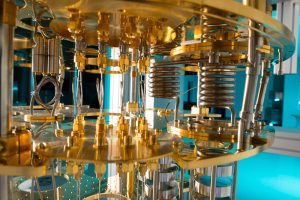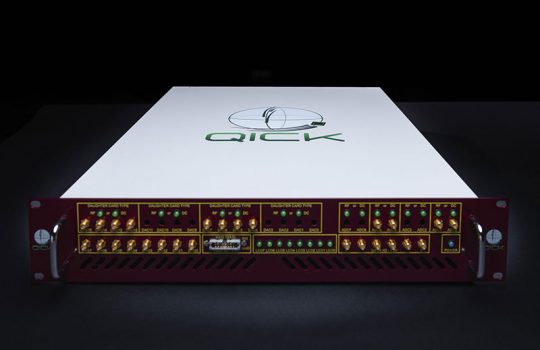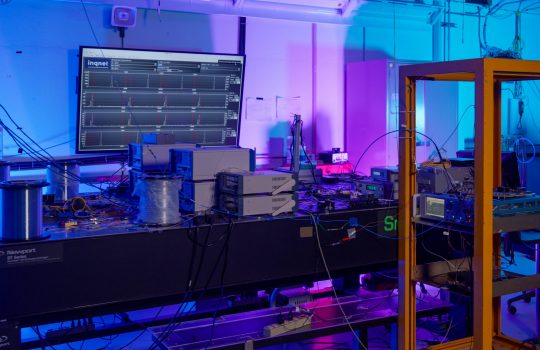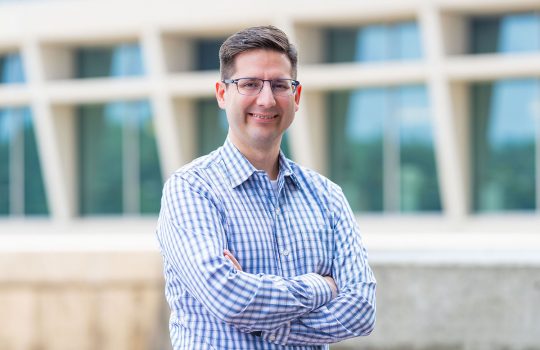
The Department of Energy’s QuantISED grants will support a number of initiatives by Fermilab scientists and their collaborators focusing on quantum computing, sensors and communication. Photo: Reidar Hahn
The U.S. Department of Energy announced today that it has awarded scientists at its Fermi National Accelerator Laboratory more than $10 million to spur research that could revolutionize not only our understanding of nature, but also the very way we investigate it.
Quantum science is a cutting-edge field of research made possible through the unique effects of quantum physics. The best known examples are quantum computing, quantum sensors and quantum teleportation, all of which Fermilab researchers will be working on in the coming years. This work – and the technology that enables it – is beyond complex, but Fermilab’s scientists and engineers, in partnership with other institutions and industry, have discovered new ways to make use of quantum effects to understand the universe.
“Scientists have understood the practical potential of quantum physics for decades, but only recently has the technology advanced to the point that we could tap into it,” said Fermilab Chief Research Officer and Deputy Director Joe Lykken. “Quantum physics has been Fermilab’s bread and butter for a half-century. With that accumulation of expertise and the technological innovation that comes with it, there’s hardly a place better positioned to explore — as a focused, dedicated program — the ways we can take full advantage of nature’s quantum behavior.”
As part of a number of grants to national laboratories and universities through its Quantum Information Science-Enabled Discovery (QuantISED) program, DOE’s funding to Fermilab scientists cover five initiatives (listed below) and will be distributed over two years. It also funds Fermilab’s participation in three further initiatives led by other institutions.
“One of the most exciting aspects of these initiatives is the way that quantum science and particle physics will advance each other. We’re pushing at the bounds of both fields,” said University of Washington graduate student Natalie Klco, who is participating in one of the funded programs. “It’s exciting to be working at a new frontier in particle physics.”
The quantum science funding announcement follows on the heels of a first-of-its-kind quantum workshop held earlier this month at Fermilab. With participants from academia and industry, it featured Google’s first quantum software tutorial in a public setting. The hands-on nature of the workshop and the face-to-face interaction among researchers from tech companies, national laboratories and universities made it an incubator for new ideas, discussions and problem-solving in quantum computing.
Fermilab is also preparing to participate in the Chicago Quantum Exchange Summit, to be held at the University of Chicago on Nov. 8 and 9. Fermilab, the U.S. Department of Energy’s Argonne National Laboratory and the University of Chicago form the core of CQE, a partnership that will facilitate the exploration of quantum information and the development of new applications with the potential to dramatically improve technology for communication, computing and sensing.
The summit will include representatives from the technical and academic sector. It will also serve as a testament to both academia’s and industry’s serious, burgeoning interest in quantum science.
“As we refer to it now, quantum science is a young field. But Fermilab is building on a 50-year foundation of world-leading quantum physics research and high-performance computing,” said Fermilab Scientific Computing Division Head Panagiotis Spentzouris. “These awards give us a way to maximize all the potential we have here. Not just for our field, but for research everywhere.”
The Fermilab-led initiatives funded through DOE’s QuantISED grants are:
1. A breakthrough technology to spot potential dark matter particles called axions
Lead principal investigator: Aaron Chou
Scientists have so far come up empty in the search for dark matter, the mysterious and as-of-yet undetectable substance that makes up a quarter of our universe. One theory suggests that dark matter might be made of exotic particles called axions. Fermilab researchers are part of a team using superconducting qubits – basic circuit elements of quantum computers that are able to detect a single photon of light – that will enable further experiments searching for axion particles.
Partner institutions: National Institute of Standards and Technology, University of Chicago, University of Colorado, Yale University
2. Particle accelerator technology to enhance qubit performance and to search for dark photons
Lead principal investigator: Alexander Romanenko
Fermilab scientists are using ultraefficient superconducting radio-frequency resonators – one of the core technologies for advancing particle accelerators – to significantly increase a quantity known as coherence time. Coherence time is how long a superposition of quantum states survives before it collapses into a single state. The longer the coherence time, the more is available for a quantum system to perform operations. Researchers are working to increase the resonators’ ability to retain energy — characterized by its quality factor — and thus the achievable coherence times. One of the main goals of this program is to demonstrate qubits with ultrahigh quality factors and long coherence times, ultimately putting a number of them together into a multiqubit, “quantum computer”-type system. The same technology will be used for experiments aimed at searching for dark photons, a particular kind of dark matter particle.
Partner institutions: National Institute of Standards and Technology, University of Wisconsin – Madison
3. Using quantum information science to aid particle physics theory work
Lead principal investigator: Marcela Carena
Researchers are using simulated quantum computers to enable computations for particle physics theory, integrating them into existing computing infrastructure to make complex and difficult calculations easier and faster. These simulations are opening avenues for physicists to address a whole new class of physics problems that were previously out of reach with classical computers.
Partner institutions: Caltech, University of Chicago, University of Washington
4. Quantum computers for machine learning and optimization
Lead principal investigator: Gabriel Perdue
Machine learning is the science of teaching computers to solve problems and fill in blanks on their own. Quantum computers are the next step in machine learning and can help make connections between pieces of information and learn how strong those connections should be. Classical computers have made great strides in this field, but quantum computers will allow scientists to build more sophisticated and powerful models of physical reality.
Partner institution: Oak Ridge National Laboratory
5. A new single-photon sensor for quantum imaging
Lead principal investigator: Juan Estrada
Scientists have developed a next-generation version of the charge-coupled device, or CCD, that’s in your home camera. This sensitive new technology, the skipper CCD, has the potential to exploit the quantum nature of light to capture images of objects with exceptional resolution. Thanks to the technology’s heightened sensitivity, the skipper CCD could image objects one photon at a time, increasing the clarity of the signal in quantum imaging experiments. Scientists are designing a skipper CCD optimized for such an application. They’re also exploring the quantum entanglement of photons as a tool to look for dark photons, a hypothetical particle related to dark matter.
Partner institutions: Lawrence Berkeley National Laboratory, Caltech
Fermilab has also been funded to participate in three initiatives led by other institutions:
1. Quantum communication channels for fundamental physics – led by Caltech
Lead principal investigator: Maria Spiropulu
Researchers have devised a way to use a phenomenon called quantum entanglement to send information over long distances. The first step toward that goal is called the Fermilab Quantum NETwork (FQNET) Teleportation Experiment, which will use a quantum network using commercial optical fibers to “teleport” information across several kilometers. This program also explores the connection of quantum teleportation protocols with deep mysteries of space-time physics that include black holes and wormholes.
Other participating institution: Harvard University
2. Quantum machine learning and quantum computation frameworks for high-energy physics – led by Caltech
Lead principal investigator: Maria Spiropulu
Machine learning algorithms have had a huge impact on the areas of pattern matching and classification. Applications at Fermilab including classifying different types of neutrino interactions in detectors and determining a particle’s path from a string of hits in a tracking chamber. With increased data volumes, scientists will require better data access methods, so researchers are also exploring the use of quantum computers for very fast data indexing and recall.
Other participating institutions: Massachusetts Institute of Technology, University of Southern California
3. Quantum computing for neutrino-nucleus dynamics – led by Los Alamos National Laboratory
Lead principal investigator: Rajan Gupta
Neutrinos are fleeting, elusive subatomic particles that may hold the key to the mystery of why we live in a matter-dominated universe. Scientists study neutrino interactions to get a better understanding of what trace the mysterious particles will leave in neutrino experiments like the Deep Underground Neutrino Experiment (DUNE), hosted by Fermilab. Quantum computers may be ideal for simulating the detailed outcomes of neutrino with complex, heavy nuclei, which are themselves quantum systems.



